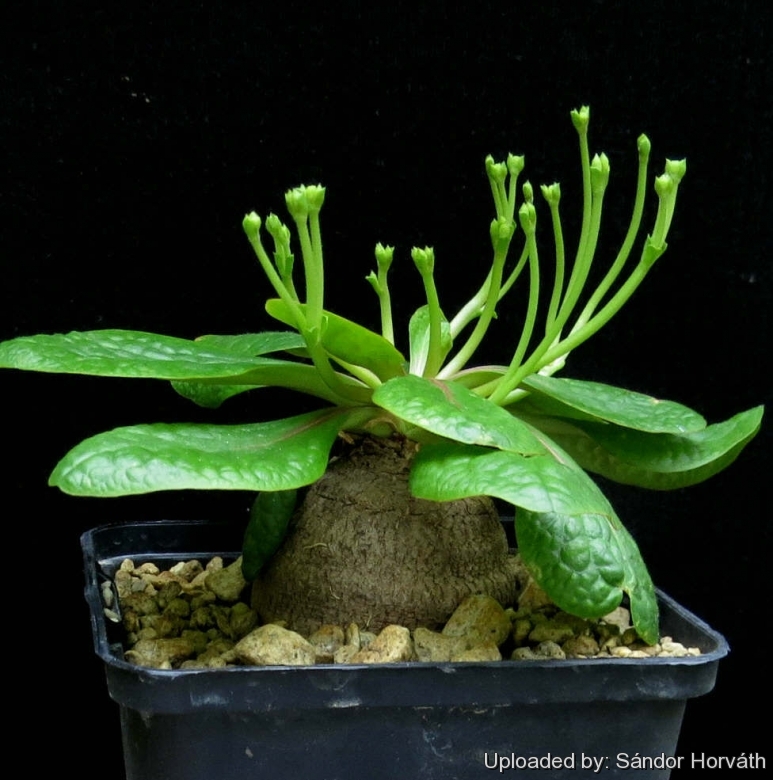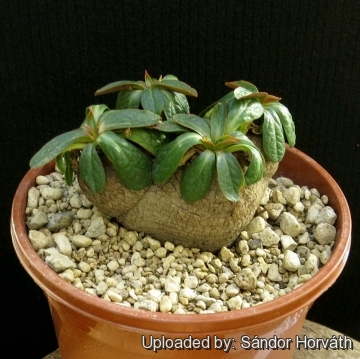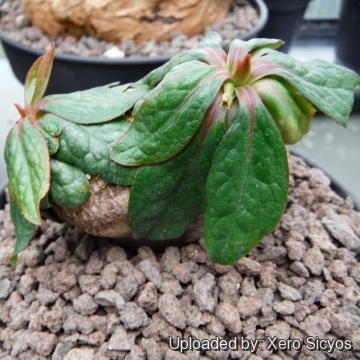




Your support is critical to our success.
- Encyclopedia of BROMELIADS
- Encyclopedia Index
- Families
- Genera
- Species
- Euphorbiaceae
- Euphorbia
- Caudiciforms
- Succulents
Since 4 Aug 2013

Origin and Habitat: South Africa, Western Cape. Although originally described from the Riversdale district, the plants also occur further to the west.
Habitat and Ecology: Euphorbia ecklonii is a winter grower and during the summer months the plants lose their leaves leaving only the tubers underground. It grows in the shade of bushes in humus-rich soil together with Haworthia magnificaSN|13271]]SN|13271]] and also Euphorbia tridentata. The population trend is stable.
Synonyms:
- Euphorbia ecklonii (Klotzsch & Garcke) A.Hässl.
- Tithymalus ecklonii Klotzsch & Garcke
Euphorbia ecklonii (Klotzsch & Garcke) A.Hässl.
Bot. Not. 1931, 335, 338.
Synonymy: 4
- Euphorbia ecklonii (Klotzsch & Garcke) A.Hässl.
- Tithymalus ecklonii Klotzsch & Garcke
- Euphorbia pistiifolia Boiss.
- Euphorbia pistiaefolia Boiss.
AFRIKAANS (Afrikaans): Melkbol, Wilderamenas
Description: Euphorbia eckloniiSN|17415]]SN|32330]] a dioecious (Male and female plants separate) geophyte herb with broadly elliptical leaves, produced for a short while each year, appearing pressed to the ground. In this succulent plant the stem seems to be almost absent, the water supply being lodged in the tuberous root. This is typical of other South-African geophyte euphorbias such as Euphorbia tuberosa and also of the rather different Euphorbia silenifoliaSN|32330]]SN|17415]]. This member of the Euphorbiaceae family was given this name by Henri Ernest Baillion in 1863
Rootstock (Caudex): Roots tuberous, merging into a very short stem, forming an elongated, perpendicular body to 2.5-3 cm in diameter, wholly buried in the ground or with 1 or more very short, or with 1 or more very short, stem-like, simple or or branched necks with apex at ground-level or just a few millimetres above ground, producing at the apex deciduous annual leaves and and inflorescences.
Leaves: Ascending-spreading, leathery, in a flattened rosette, elliptic, 2-5 cm long, 1 to 2.5 cm broad. Petiole s 12 to 37 cm long. Base cuneate. Apex obtuse, rounded or emarginate, sometimes crisped at the margins. Glabrous or puberulous on the petiole and midrib beneath.
Inflorescences (cymes): 1 to 7 per plant, in 3- to 5-rayed umbels, each producing 3-5 cyathia, peduncles to 2-5 cm long. Bra 3 or 4 sessile, obovate, to 4-8 mm long, 4.5 mm broad, puberulous.
Flowers (cyathia): Unisexual, cup-shaped, 4-5 mm in diameter, puberulous. Nectar-glands 5 elliptic with subquadrate, toothed lobes.
Female flower: Ovary finely hairy, at first more or less included in the involucre, in the fruiting stage exserted on a pedicel about as long as the involucre. Styles 2 to 2.5 m. long, united into a column at the base for half their length, free above, with spreading 2-lobed tips, finely hairy or glabrous.
Blooming season: Late winter, with a peak in August.
Fruits (capsules): Subglobose-trigonous, 4.5-7 mm in diameter, velvety, subsessile.
Seeds: Ovoid, to 2.7 mm, obscurely 4-angled, minutely tuberculate at first reddish, becoming faintly greenish-grey when ripe.
Bibliography: Major references and further lectures
1) Urs Eggli “Illustrated Handbook of Succulent Plants: Dicotyledons” Springer Science & Business Media, 2002
2) Archer, R.H. & Victor, J.E. 2005. “Euphorbia ecklonii (Klotzsch & Garcke) Baill.” National Assessment: Red List of South African Plants version 2015.1. Accessed on 2016/01/14
3) Doreen Court “Succulent Flora of Southern Africa” CRC Press, 01 June 2000
4) Alain Campbell White, Robert Allen Dyer, Boyd L. Sloane “The succelent Euphorbisae (southern Africa)” Abbey garden press, 1941
5) Pauline Bohnen “Flowering plants of the Southern Cape” Still Bay Trust, 1986
6) Pjotr Lawant & Rikus van Veldhuisen “A monograph about some long existing taxonomic mysteries ...” Published May 2014, comprising texts first published in Euphorbia World 10(1), April 2014 <http://www.euphorbia-international.org/add_texts/A%20monograph%20about%20some%20long%20existing%20taxonomic%20mysteries.pdf> web 14 January 2016

Euphorbia ecklonii Photo by: Sándor Horváth

Euphorbia ecklonii Photo by: Xero Sicyos
Cultivation and Propagation: Euphorbia ecklonii is not easy and the plants can easily rot. The plants should receive water mainly in winter and be grown in a well drained sandy soil. It has been propagated by seed only. It rests in summer and produces new leaves and inflorescences in winter, the older leaves wither and drop in spring. Euphorbia eckloniiSN|32330]]SN|32330]] is a particular favourite of caudiciform plant enthusiasts. It is particularly prone to rot if left cold and damp while dormant.
Caudex exposure: The remarkable succulent rootstock or caudex is usually raised above the soil line so that this can be seen and more readily appreciated.
Soil and pots: It likes pots with generous drain holes, needs a very airy potting medium which mainly consists of non organic material such us clay, pumice, lava grit, and only a little peat or leaf-mould, seeing that the main trunk is planted with the majority of the roots below the caudex line. It's rare that it will use the upper third of its soil and often this area serves like a mulch or support for the stem.
Fertilization: Need a perfect fertilizer diet in summer. Use preferably a cacti and succulents fertilizer with high potassium content including all micro nutrients and trace elements or slow release fertilizer.
Exposure: This plant has an excellent heat tolerance, and need full sun to light shade exposures, but can tolerate shade.
Watering: Water regularly during the active growing season. No water should ever be allowed to stand around the roots. Keep almost completely dry in winter. Even though the swollen caudex ensures a long lasting water reserve making it very tolerant of under watering, this euphorbia is difficult, turning immediately to mush when over watered, or watered out of season. Care must be given in watering, keeping them warm and wet while growing, and cooler and dry when dormant.
Hardiness: Tender. This spurge can be difficult to get it to look its best without a good amount of heat and sun and so it is only really suited to the tropics (USDA Zones 10-11). Keep the plant cooler in winter, but maintain the light as bright as you can so that any growth which it may produce at this time will not be etiolated. Protection in a warm greenhouse in the middle of the winter will greatly increase the survival rate.
Rot: Rot it is only a minor problem with Euphorbias if the plants are watered and “aired” correctly. If they are not, fungicides won't help all that much. It is very unlikely to lose this plant from root rot from excessive water.
Known hazards: The latex/sap is poisonous and can cause skin rash, itching and general discomfort, and they should be handled with caution, particularly when pruning.
Propagation: The plant can be only reproduced by seeds.
| Your Actions | |
|---|---|
| Back to Euphorbia index | |
| Back to Euphorbiaceae index | |
 |
Back to Bromeliads Encyclopedia index |
Privacy stantement - Terms and conditions - How to cite - About us - Feedback - Donate


